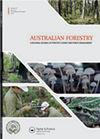Developing Indigenous commercial forestry in northern Australia
IF 1.2
4区 农林科学
Q3 FORESTRY
引用次数: 4
Abstract
ABSTRACT Indigenous communities in northern Australia own and manage around 46 million ha of forest. Some of these forests currently support a small and socioeconomically important Indigenous commercial forestry and forest products industry. There is much unrealised potential for the further development of this culturally appropriate industry for remote northern Australian Indigenous communities. This study presents new and existing data on forests and forestry in regions across northern Australia and uses a literature review and stakeholder consultations to explore the growth potential of Indigenous commercial forestry in these regions. Relevant literature was mapped to identify trends, biases and gaps; three regional forums were held; and case studies were prepared for three Indigenous commercial forestry enterprises—one in western Cape York Peninsula in Queensland and one each in east Arnhem Land and the Tiwi Islands in the Northern Territory. These three regions have substantial Indigenous commercial forestry growth potential. The case studies and subsequent discussions point to key opportunities, challenges and needs for the further development of the Indigenous commercial forestry industry in northern Australia. The discussion centres around four emergent themes—commercial native forests, plantation forestry, mine rehabilitation and capacity building. Policy, investment and other priority research and development needs are outlined. These include native forest inventory, silvicultural trials and long-term monitoring; new plantation forestry trials; pre-mining forest salvage harvesting and integrated product utilisation; the processing of local timbers in community sawmills for local applications; multiple-use community forestry in mine rehabilitation; locally designed, field-based ‘forest ranger’ training programs; technical and tertiary professional forestry education pathways; and business development support, including mentoring. The findings can inform decision-making by regional development researchers, policymakers and investors to support local Indigenous commercial forestry initiatives for community, environmental and livelihood benefits in northern Australia and elsewhere.在澳大利亚北部发展土著商业林业
摘要澳大利亚北部的土著社区拥有并管理着约4600万公顷的森林。其中一些森林目前支持一个小型的、具有社会经济重要性的土著商业林业和林产品产业。对于偏远的澳大利亚北部土著社区来说,进一步发展这一文化适宜的产业还有很多未实现的潜力。这项研究提供了澳大利亚北部地区森林和林业的新数据和现有数据,并利用文献综述和利益相关者协商来探索这些地区土著商业林业的增长潜力。绘制相关文献图,以确定趋势、偏见和差距;举行了三次区域论坛;并为三家土著商业林业企业编写了案例研究——一家位于昆士兰约克角半岛西部,另一家位于北领地阿纳姆地东部和提维群岛。这三个地区具有巨大的本土商业林业增长潜力。案例研究和随后的讨论指出了澳大利亚北部土著商业林业进一步发展的关键机遇、挑战和需求。讨论围绕四个新兴主题展开——商业原生森林、人工林、矿山恢复和能力建设。概述了政策、投资和其他优先研发需求。其中包括原生森林清查、造林试验和长期监测;新的人工林试验;采前森林抢救性采伐和产品综合利用;在社区锯木厂加工当地木材,供当地使用;矿山修复中的多用途社区林业;当地设计的实地“护林员”培训计划;林业技术和高等专业教育途径;以及业务发展支助,包括辅导。这些发现可以为区域发展研究人员、政策制定者和投资者的决策提供信息,以支持澳大利亚北部和其他地方为社区、环境和生计利益而采取的当地土著商业林业举措。
本文章由计算机程序翻译,如有差异,请以英文原文为准。
求助全文
约1分钟内获得全文
求助全文
来源期刊

Australian Forestry
FORESTRY-
CiteScore
3.70
自引率
4.80%
发文量
15
审稿时长
>12 weeks
期刊介绍:
Australian Forestry is published by Taylor & Francis for the Institute of Foresters of Australia (IFA) for scientific, technical, and professional communication relating to forestry in the Asia Pacific.
 求助内容:
求助内容: 应助结果提醒方式:
应助结果提醒方式:


